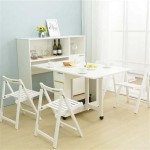How to Stage a Dining Room Table for Impact
Staging a dining room table effectively is a crucial component in presenting a home for sale or rent. A well-staged dining area can evoke aspirational lifestyles, showcasing the space's potential for memorable gatherings and everyday meals. The goal is to create an inviting and visually appealing setting that inspires potential buyers or renters to envision themselves living and entertaining in the space. This article outlines a comprehensive approach to staging a dining room table, addressing key elements that contribute to a successful and impactful presentation.
Understanding the Target Audience and Market
Before commencing the staging process, it is essential to understand the target demographic and the prevailing market trends. Different demographics gravitate towards distinct styles and aesthetics. For example, a home targeting young professionals might benefit from a modern and minimalist staging approach, while a property aimed at families could be enhanced by a more traditional and comforting design.
Market research is also critical. Examine comparable properties in the area and identify successful staging techniques they employ. This analysis provides insights into what resonates with local buyers or renters and helps inform the staging strategy for the specific property. Consider factors such as the overall architectural style of the home, the neighborhood's characteristics, and the price point of the property.
Furthermore, assess the existing condition of the dining room itself. Identify any features that should be highlighted, such as a beautiful view, natural light, or architectural details. Conversely, address any potential drawbacks, such as a small size or awkward layout. Staging can be used to mitigate these issues and emphasize the room's positive attributes.
Selecting a Cohesive Style and Color Palette
The choice of style and color palette plays a significant role in creating an appealing dining room setting. Consistency is crucial; the chosen style should complement the overall aesthetic of the home. A modern home, for instance, would benefit from a contemporary dining room staging, whereas a more traditional home might suit a classic or farmhouse style.
The color palette should be carefully considered to create a harmonious and inviting atmosphere. Neutral colors, such as whites, grays, and beiges, are generally safe choices as they appeal to a broad range of tastes. However, incorporating subtle pops of color can add visual interest and personality. Consider using accent colors that complement the existing décor or highlight specific features of the room.
When selecting linens, tableware, and décor items, ensure they align with the chosen style and color palette. Avoid mixing clashing patterns or colors. Instead, opt for items that complement each other and create a cohesive and visually pleasing arrangement.
Consider the lighting in the dining room when selecting colors. Darker colors can make a room feel smaller and more enclosed, while lighter colors can create a sense of spaciousness. If the dining room lacks natural light, opt for lighter colors and ample artificial lighting to brighten the space.
Creating an Inviting Table Setting
The table setting is the focal point of the dining room staging. It should be carefully curated to create an inviting and aesthetically pleasing arrangement. The goal is to showcase the table's potential for hosting meals and gatherings without appearing cluttered or overwhelming.
Begin with a tablecloth or runner that complements the chosen style and color palette. A tablecloth can add a touch of formality and elegance, while a runner can provide a more casual and contemporary feel. Ensure the table linen is clean, wrinkle-free, and appropriately sized for the table.
Next, select tableware that complements the chosen style. Avoid using mismatched or outdated dishes. Instead, opt for a cohesive set that is in good condition. Consider using chargers beneath the plates to add visual interest and a touch of sophistication.
The placement of silverware and glassware is also important. Follow traditional table setting etiquette to create a polished and professional look. Use appropriate glassware for the occasion, such as wine glasses, water glasses, and champagne flutes.
Centerpieces can add visual interest and personality to the table setting. However, avoid using overly large or obstructive centerpieces that impede conversation. Instead, opt for a smaller, more understated centerpiece, such as a floral arrangement, a decorative bowl, or a collection of candles. The height of the centerpiece should allow for unobstructed views across the table.
Consider adding personal touches to the table setting, such as place cards or small favors. These details can create a sense of warmth and hospitality, making potential buyers or renters feel more welcome in the space.
Optimizing the Surrounding Space
Staging the dining room effectively involves more than just setting the table. The surrounding space should also be optimized to create a cohesive and inviting atmosphere. This includes addressing the walls, lighting, furniture, and accessories.
Ensure the walls are clean and in good condition. A fresh coat of paint can significantly enhance the appearance of the dining room. Consider using neutral colors that complement the chosen style and color palette.
Lighting plays a crucial role in creating a warm and inviting atmosphere. Ensure the dining room has adequate lighting, both natural and artificial. Consider adding a chandelier or pendant light above the table to create a focal point. Supplement this with ambient lighting, such as lamps or sconces, to create a soft and inviting glow.
The furniture in the dining room should be arranged to maximize space and create a functional layout. Ensure there is enough room for people to move around the table comfortably. Consider removing any unnecessary furniture to create a more spacious feel.
Accessories can add personality and visual interest to the dining room. However, avoid cluttering the space with too many accessories. Instead, opt for a few carefully chosen items that complement the chosen style and color palette. Consider adding artwork, mirrors, or decorative objects to enhance the overall aesthetic of the room.
Pay attention to the details. Ensure the dining room is clean and well-maintained. Remove any clutter or personal items that may distract potential buyers or renters. A clean and organized dining room creates a positive impression and allows potential buyers or renters to envision themselves living in the space.
Strategic Use of Color and Texture
The strategic integration of color and texture significantly enhances the overall appeal of a staged dining room. Color psychology plays a crucial role in influencing emotions and perceptions. Warm colors, like yellows and oranges, can evoke feelings of happiness and energy, while cool colors, such as blues and greens, promote tranquility and relaxation.
Utilizing a balanced color palette is key. Too much of one color can be overwhelming, while a lack of color can make the room feel sterile and uninviting. Consider incorporating a dominant color, an accent color, and a neutral color to create a visually harmonious and balanced space.
Texture adds depth and dimension to the dining room. Incorporate a variety of textures through linens, upholstery, and décor items. For example, a textured tablecloth can add visual interest, while plush cushions can create a sense of comfort and luxury. Different materials, such as wood, metal, and glass, also contribute to the overall textural landscape of the room.
Layering textures strategically can create a more inviting and visually appealing space. Consider pairing smooth textures with rough textures to create contrast and visual interest. For example, a smooth glass vase can be paired with a rough-textured linen tablecloth.
The use of patterns should be carefully considered. Too many patterns can create a cluttered and overwhelming look, while a lack of patterns can make the room feel bland and uninspired. Consider incorporating a subtle pattern on the tablecloth or curtains to add visual interest without overpowering the space.
Maintaining a Sense of Neutrality
While adding personal touches is important, maintaining a sense of neutrality is crucial. The goal of staging is to appeal to a broad range of tastes and preferences. Avoid incorporating overly personalized items or décor that may alienate potential buyers or renters.
Remove any personal photographs or memorabilia that may distract potential buyers or renters. These items can make it difficult for them to envision themselves living in the space. Instead, opt for generic artwork or decorative items that are more universally appealing.
Avoid using strong or divisive colors that may turn off potential buyers or renters. Neutral colors, such as whites, grays, and beiges, are generally safe choices as they appeal to a broad range of tastes. If incorporating accent colors, choose subtle shades that complement the overall color palette.
Consider the overall style of the home when selecting décor items. Ensure the décor complements the architectural style and existing features of the home. Avoid incorporating items that clash with the overall aesthetic.
Staging should enhance the positive attributes of the dining room without overshadowing the space itself. The goal is to create a blank canvas that allows potential buyers or renters to envision themselves living in the space and making it their own.

5 Guidelines For Staging The Dining Room Mhm Professional

To Set Or Not The Dining Table Foxy Home Staging

5 Guidelines For Staging The Dining Room Mhm Professional

Staging A Table Expert Home Tips 2024 Guide

6 Quick Easy Dining Room Staging Tips Virtually Properties

Staging The Dining Room

9 Best Dining Room Staging Tips For A Winning Showcase

How To Stage Your Dining Room Homestagingbrisbane

How To Stage Your Dining Room Rismedia

Staging The Dining Room








